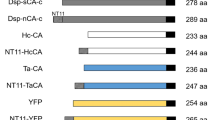Abstract
Improper protein-folding often results in inclusion-body formation in a protein expression system using Escherichia coli. To express such proteins in the soluble fraction of E. coli cytoplasm, we developed an expression system by fusing the target protein with an archaeal FK506 binding protein (FKBP). It has been reported that an archaeal FKBP from a hyperthermophilic archaeon, Thermococcus sp. KS-1 (TcFKBP18), possesses not only peptidyl–prolyl cis–trans isomerase activity, but also chaperone-like activity to enhance the refolding yield of an unfolded protein by suppressing irreversible protein aggregation. To study the effect of this fusion strategy with FKBP on the expression of foreign protein in E. coli, a putative rhodanese (thiosulfate sulfurtransferase) from a hyperthermophilic archaeon and two mouse antibody fragments were used as model target proteins. When they were expressed alone in E. coli, they formed insoluble aggregates. Their genes were designed to be expressed as a fusion protein by connecting them to the C-terminal end of TcFKBP18 with an oligopeptide containing a thrombin cleavage site. By fusing TcFKBP18, the expression of the target protein in the soluble fraction was significantly increased. The percentage of the soluble form in the expressed protein reached 10–28% of the host soluble proteins. After purification and protease digestion of the expressed antibody fragment–TcFKBP18 fusion protein, the cleaved antibody fragment (single-chain Fv) showed specific binding to the antigen in ELISA. This indicated that the expressed antibody fragment properly folded to the active form.




Similar content being viewed by others
References
Bach H, Mazor Y, Shaky S, Shoham-Lev A, Berdichevsky Y, Gutnick DL, Benhar I (2001) Escherichia coli maltose-binding protein as a molecular chaperone for recombinant intracellular cytoplasmic single-chain antibodies. J Mol Biol 312:79–93
Cabilly S (1989) Growth at sub-optimal temperatures allows the production of functional, antigen-binding Fab fragments in Escherichia coli. Gene 85:553–557
Fischer G, Schmid FX (1999) Peptidyl-prolyl cis/trans isomerases in molecular chaperones and folding catalysts. Harwood Academic, Amsterdam, pp 461–489
Furutani M, Ideno A, Iida T, Maruyama T (2000) FK506 binding protein from a thermophilic archaeon, Methanococcus thermolithotrophicus has chaperone-like activity in vitro. Biochemistry 39:453–462
Gething MJ, Sambrook J (1992) Protein folding in the cell. Nature 355:33–45
Glockshuber R, Schmidt T, Plückthun A (1992) The disulfide bonds in antibody variable domains: effects on stability, folding in vitro, and functional expression in Escherichia coli. Biochemistry 31:1270–1279
Harrison RK, Stein RL (1990) Substrate specificities of the peptidyl prolyl cis–trans isomerase activities of cyclophilin and FK-506 binding protein: evidence for the existence of a family of distinct enzymes. Biochemistry 29:3813–3816
Iba Y, Ito W, Kurosawa Y (1997) Expression vectors for the introduction of highly diverged sequences into the six complementarity-determining regions of an antibody. Gene 194:35–46
Ideno A, Yoshida T, Furutani M, Maruyama T (2000) The 28.3 kDa FK506 binding protein from a thermophilic archaeum, Methanobacterium thermoautotrophicum, protects the denaturation of proteins in vitro. Eur J Biochem 267:3139–3149
Ideno A, Yoshida T, Iida T, Furutani M, Maruyama T (2001) FK506-binding protein of the hyperthermophilic archaeum, Thermococcus sp. KS-1, a cold-shock-inducible peptidyl-prolyl cis–trans isomerase with activities to trap and refold denatured proteins. Biochem J 357:465–471
Ideno A, Furutani M, Iba Y, Kurosawa Y, Maruyama T (2002) FK506 binding protein from the hyperthermophilic archaeum, Pyrococcus horikoshii, suppresses the aggregation of proteins in Escherichia coli. Appl Environ Microbiol 68:464–469
Iida T, Furutani M, Nishida F, Maruyama T (1998) FKBP-type peptidyl-prolyl cis–trans isomerase from a sulfur-dependent hyperthermophilic archaeon, Thermococcus sp. KS-1. Gene 222:249–255
Kawarabayashi Y, Hino Y, Horikawa H, Yamamoto S, Haikawa Y, Jin-no K, Takahashi M, Sekine M, Baba S, Ankai A, Kosugi H, Hosoyama A, Fukui S, Nagai Y, Nishijima K, Nakazawa H, Takamiya M, Masuda S, Funahashi T, Tanaka T, Kudoh Y, Yamazaki J, Kushida N, Oguchi A, Aoki K, Kubota K, Nakamura Y, Nomura N, Sako Y, Kikuchi H (1999) Complete genome sequence of an aerobic hyper-thermophilic crenarchaeon, Aeropyrum pernix K1. DNA Res 6:83–101
Kipriyanov SM, Little M (1999) Generation of recombinant antibodies. Mol Biotechnol 12:173–201
Levy R, Weiss R, Chen G, Iverson BL, Georgiou G (2001) Production of correctly folded Fab antibody fragment in the cytoplasm of Escherichia coli trxB gor mutants via the coexpression of molecular chaperones. Protein Expr Purif 23:338–347
Maruyama T, Furutani M (2000) Archaeal peptidyl prolyl cis–trans isomerases (PPIase). Front Biosci 5:821–836
Nishihara K, Kanemori M, Kitagawa M, Yanagi H, Yura T (1998) Chaperone coexpression plasmids: differential and synergistic roles of DnaK-DnaJ-GrpE and GroEL-GroES in assisting folding of an allergen of Japanese cedar pollen, Cryj2, in Escherichia coli. Appl Environ Microbiol 64:1694–1699
Nishihara K, Kanemori M, Yanagi H, Yura T (2000) Overexpression of trigger factor prevents aggregation of recombinant proteins in Escherichia coli. Appl Environ Microbiol 66:884–889
Proba K, Ge L, Plückthun A (1995) Functional antibody single-chain fragments from the cytoplasm of Escherichia coli: influence of thioredoxin reductase (TrxB). Gene 159:203–207
Richarme G, Caldas TD (1997) Chaperone properties of the bacterial periplasmic substrate-binding proteins. J Biol Chem 272:15607–15612
Smith DB, Johnson KS (1988) Single-step purification of polypeptides expressed in Escherichia coli as fusions with glutathione S-transferase. Gene 67:31–40
Wang CC, Tsou CL (1998) Enzymes as chaperones and chaperones as enzymes. FEBS Lett 425:382–384
Acknowledgement
We thank Ms. H. Iwabuchi for her technical assistance.
Author information
Authors and Affiliations
Corresponding author
Rights and permissions
About this article
Cite this article
Ideno, A., Furutani, M., Iwabuchi, T. et al. Expression of foreign proteins in Escherichia coli by fusing with an archaeal FK506 binding protein. Appl Microbiol Biotechnol 64, 99–105 (2004). https://doi.org/10.1007/s00253-003-1459-4
Received:
Revised:
Accepted:
Published:
Issue Date:
DOI: https://doi.org/10.1007/s00253-003-1459-4




